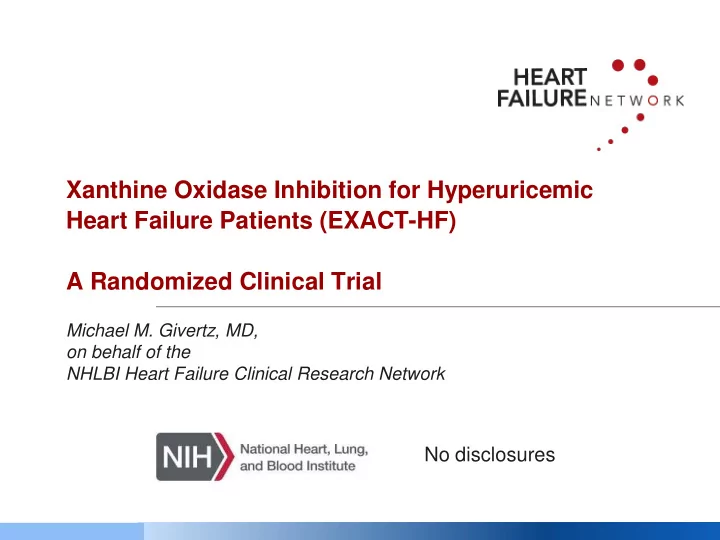

Xanthine Oxidase Inhibition for Hyperuricemic Heart Failure Patients (EXACT-HF) A Randomized Clinical Trial Michael M. Givertz, MD, on behalf of the NHLBI Heart Failure Clinical Research Network No disclosures
Background ● Despite guideline-recommended therapy for patients with heart failure (HF) and reduced ejection fraction, morbidity and mortality remain high ● Oxidative stress contributes to ventricular and vascular remodeling and disease progression in HF ● Xanthine oxidase (XO) is a potential source of oxidative stress in HF, and therefore a logical target for therapy ● Allopurinol is a potent XO inhibitor that may reverse several pathophysiological processes occurring in failing myocardium
Background ● Acute studies in HF have shown that allopurinol can: ● ↑ myocardial efficiency and reduce MVO 2 ● ↑ high -energy phosphates and ATP flux ● Chronic studies have shown improved endothelium- dependent vasodilation and regression of LVH ● OPT-CHF randomized patients with moderate-severe HF to 6 months of treatment with oxypurinol or placebo ● No clinical benefit in overall study population ● Signal of benefit in hyperuricemic (UA ≥ 9.5 mg/dl) patients
Hypothesis • In patients with symptomatic HF due to left ventricular systolic dysfunction and elevated serum uric acid levels, treatment with allopurinol for 24 weeks will improve clinical outcomes compared to treatment with placebo
Study Population ● NYHA Class II-IV ● HF symptoms for 3 months despite standard therapy ● LVEF ≤ 40% ● Serum UA level ≥ 9.5 mg/dl ● One additional marker of increased risk: ● Hospitalization or ER visit for HF requiring IV diuretics within 12 months ● LVEF ≤ 25% ● BNP > 250 pg/ml or NT-pro-BNP level > 1500 pg/ml
Study Design Follow-up visits Allo Allo 300 mg 600 mg Double-blind 1:1 randomization Screen Baseline Stratified by site and creatinine Placebo Placebo -7-14 days Day 0 Day 7-10 4 wk 12 wk 24 wk
Primary Endpoint ● Composite clinical endpoint (CCE) ● Classifies a subject’ s clinical status as improved, worsened, or unchanged at 24 weeks based on hierarchical outcomes of: ● Death ● Hospitalization, emergency room or urgent clinic visit for worsening HF ● Medication change for worsening HF ● Patient Global Assessment
Study Endpoints ● Secondary endpoints at 12 and 24 weeks ● Change in quality of life (KCCQ) ● Change in submaximal exercise capacity (6-MWT) ● Other endpoints ● Echocardiographic measures of LV remodeling ● Biomarkers of HF (UA, NT-pro-BNP, cystatin C) and oxidative stress (myeloperoxidase) ● Time to first HF hospitalization and to all-cause death and hospitalization
Statistical Methods ● All analyses conducted using intention to treat ● Row mean score statistic used to compare distributions of primary CCE ● 250 patients (125 per group) needed to provide 83% power to detect statistically significant difference ● Changes from baseline between treatment groups ● assessed at each time point with adjustment for baseline value ● missing values handled using multiple imputation ● Cumulative event rates estimated using Kaplan-Meier method
Baseline Characteristics Allopurinol Placebo Characteristic (N = 128) (N = 125) Age (years) 63 63 Male sex 86% 78%* White race 71% 62% Duration of heart failure (years) 5.1 5.5 NYHA class II / III / IV 46% / 52% / 2% 49% / 49% / 2% LV ejection fraction 25% 23% Ischemic cardiomyopathy 55% 51% Diabetes 57% 52% Hypertension 77% 79% Atrial fibrillation or flutter 52% 46% Gout 20% 25% *p-value < 0.05 Median values or % shown
Baseline Characteristics Allopurinol Placebo Characteristic (N = 128) (N = 125) Medications ACE inhibitor/ARB 84% 86% Beta-blocker 96% 94% Aldosterone antagonist 55% 50% Digoxin 39% 46%* ICD 67% 69% Systolic blood pressure (mmHg) 108 108 Heart rate (beats/min) 72 74 BMI (kg/m 2 ) 30.8 31.6 Cystatin C (mg/dL) 1.44 1.34 NT-pro-BNP (pg/mL) 2708 2283 Uric acid (mg/dL) 11.0 11.1 Median values or % shown *p-value < 0.05
Uric Acid Levels 12 10 Uric acid, mg/dL 8 Allopurinol 6 P<0.0001 P<0.0001 Placebo 4 2 0 Baseline 12 weeks 24 weeks
Primary Endpoint 50 45 Overall P=0.25 40 35 Percent 30 Allopurinol 25 Placebo 20 15 10 5 0 Worsenend Unchanged Improved
Secondary Endpoints Quality of Life Submaximal Exercise 70 350 P=0.64 P=0.41 P=0.16 P=0.75 Overall summary score 60 300 Distance walked (m) 50 250 40 200 30 150 20 100 10 50 0 0 Baseline 12 Weeks 24 Weeks Baseline 12 Weeks 24 Weeks Allopurinol Placebo Allopurinol Placebo
Other Endpoints ● No differences in LV volumes, mass or ejection fraction ● No differences in cystatin C, NT-pro-BNP or myeloperoxidase ● No difference in proportion of patients who died (6%), had an unscheduled outpatient visit (30%), or were hospitalized (38%) for any reason ● No difference in proportion of patients who were moderately or markedly better on Patient Global Assessment
Risk of Death or Hospitalization
Risk of HF Hospitalization
Adverse Events Allopurinol Placebo Characteristic (N = 128) (N = 125) Any adverse event 63 58 Serious adverse event 20 15 Cardiac 2 2 Gastrointestinal 15 11 Infection 19 13 Musculoskeletal 15 10 Nervous system 3 4 Renal and urinary 1 3 Respiratory 6 6 Skin and subcutaneous tissue 15* 6 Rash 10* 2 *p-value < 0.05 % shown
Conclusions ● In HF patients with reduced ejection fraction and hyperuricemia, XO inhibition with allopurinol: ● safely lowers uric acid levels, but ● has no beneficial effects on clinical status, exercise capacity, quality of life, or LV structure and function ● Other adjunctive therapies for high-risk HF patients are needed
Thank You Montreal Heart Institute University of Vermont/ Minnesota Heart Tufts University Failure Consortium Harvard University Mayo Clinic U. Pennsylvania University of Utah Cleveland Thomas Jefferson University NHLBI Washington University DCRI Duke University Emory University Morehouse School of Medicine Baylor College of Medicine
Recommend
More recommend